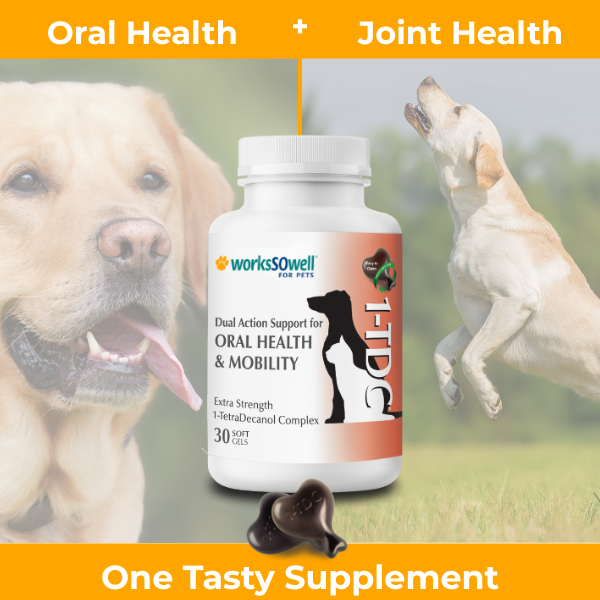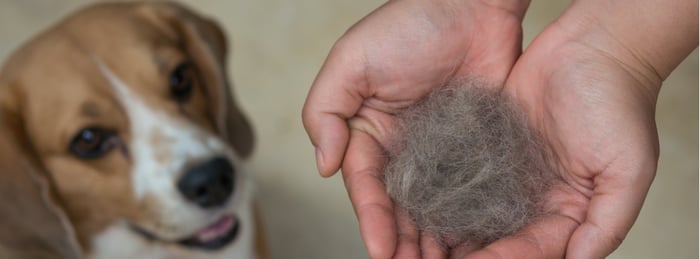Why Is My Dog’s Fur Falling Out?
While most dogs shed, sometimes you might notice that your dog is losing more fur than usual. The fur loss could be all over the entire body or centered in one specific area, creating a bald spot. In some cases, a dog’s whole coat could look patchy and sparse. So like a good parent you're probably asking yourself "why is my dog's fur falling out?"
There are many potential reasons that could explain your dog’s fur falling out, and they range from mild to potentially serious. Read on to find out why your dog’s fur might be falling out, as well as some suggestions for treating the underlying condition.
1) Seasonal Shedding
Some dogs seem to shed a lot all of the time, while other dogs tend not to shed much except for once or twice per year when they “blow their coats.” If you have never had a dog with a thick undercoat, this can be disconcerting the first time you see it.
The dog can go from looking completely normal one day to having large tufts of hair sticking out all over the next day.
The breeds that tend to blow their coats during shedding season include the following:
- German Shepherds
- Akitas
- Siberian Huskies
- Beagles
- Pugs
- Pekingese
- Bernese Mountain Dogs
- Collies
The reason they shed their coats like this is to prepare for the warmer weather, so there isn’t anything you should do to stop it. Brushing your dog twice per day will help remove the dead hair more quickly. You can also use a shedding blade to help strip the loose fur from his coat.
In the meantime, you’ll need to vacuum more frequently. The good news is that this process only lasts a couple of weeks.
2) Fleas and Allergies
A flea infestation or allergies can cause your dog to feel itchy and scratch or bite his fur. This causes either an all-over patchy look or bald spots.
In some dogs, even one or two fleabites can cause a reaction that includes fur loss. Other dogs are allergic to dog shampoo, dust mites, pollen, their food, and a wide range of other things that can cause itching and fur loss. If your dog has fleas, you will need to treat them.
Talk to your veterinarian about the best way to treat the infestation without further irritating your dog’s skin. You should also have your dog on some type of flea preventative, whether that is oral medication or topical medication that you place on the back of your dog’s neck.
Flea collars are not highly recommended, as they have limited results and can cause further irritation and fur loss in some dogs. If your dog has allergies to something else, however, you will need to discover what the offending substance is.
Allergy testing is one possibility. If you suspect that the dog’s food is the issue, you could try slowly switching him over to another type of food, but be aware that it will take weeks to go through the process of switching and waiting to see what the results are.
Some dogs take allergy medication to help control their symptoms of environmental allergies. You can also try baths and wiping down your dog after each trip outdoors.
3) Cushing’s Disease
Cushing’s disease is a condition in which the adrenal glands make too much of certain hormones. Dogs with the condition tend to have thinning fur. Other symptoms include an increase in appetite and thirst, frequent urination, and lethargic behavior.
There are three different types of Cushing’s disease, and the type will determine the treatment…
- A tumor on the pituitary gland
- A tumor on the adrenal gland
- Excessive cortisol levels from the prolonged use of steroids for some other medical condition
If you notice similar symptoms in your dog, it is important to visit the veterinarian promptly for testing and a diagnosis. Many times, Cushing’s disease is treatable or controllable with medication.
However, some dogs require surgery. If there is a large tumor, the prognosis is not as good, but many dogs can live for years while having the condition treated.
4) Genetic Balding
Some breeds are prone to harmless genetic balding. Some affected breeds include Chihuahuas, Greyhounds, Whippets, and Dachshunds.
If your dog is developing bald spots that are not accompanied by itching or any other symptoms, this could be the cause. Genetic balding is benign and there is not really much you can do about it.
It is important to have the balding evaluated by your veterinarian to be sure that it is not an early symptom of Cushing’s disease or any other condition that might require treatment.
5) Ringworm and Hot Spots
Finally, there are some reasons that your dog might develop bald spots. Ringworm is a fungal infection that causes round patches of hairlessness. The skin might look scaly, flaky, darkened, or red.
It might be itchy, but a lack of itchiness does not confirm or rule out ringworm. Ringworm can spread not only to your other pets but also to humans, so it is important to have it evaluated promptly and treated. Some dogs develop what are called “hot spots” that can cause bald spots.
Hot spots often start with an insect bite or some other irritation. Some dogs will create a lick sore on a limb because they are bored or frustrated. The common factor is that these small sores will soon turn into larger skin infections. The skin will become red and may ooze blood or pus.
The fur will fall out around the hot spot. These require antibiotic ointment and sometimes an oral antibiotic. A steroid might also be prescribed. Your dog might need to wear a cone collar to prevent him from further chewing or licking at the spot while it heals.
If you have questions about your dog’s fur falling out, be it thinning fur, bald spots, or patches in the fur, contact your veterinarian, who can run the proper tests and recommend the appropriate treatment.
Also 1-TDC can provide great benefits for your pet's skin & coat
1-TDC Oral Health + Mobility Support for Dogs

$33.00
Keep your pet Happy, Active & Comfortable from Head-to-Tail with 1-TDC. This unique supplement is SO effective that it is recommended by TOP Veterinary Experts worldwide to maintain and improve your pet’s health in 4 important areas: Oral Health….… read more









